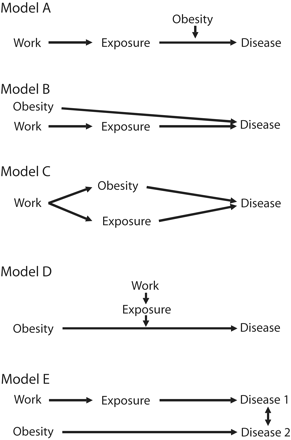Work, obesity, and occupational safety and health
- PMID: 17267711
- PMCID: PMC1805035
- DOI: 10.2105/AJPH.2006.086900
Work, obesity, and occupational safety and health
Abstract
There is increasing evidence that obesity and overweight may be related, in part, to adverse work conditions. In particular, the risk of obesity may increase in high-demand, low-control work environments, and for those who work long hours. In addition, obesity may modify the risk for vibration-induced injury and certain occupational musculoskeletal disorders. We hypothesized that obesity may also be a co-risk factor for the development of occupational asthma and cardiovascular disease that and it may modify the worker's response to occupational stress, immune response to chemical exposures, and risk of disease from occupational neurotoxins. We developed 5 conceptual models of the interrelationship of work, obesity, and occupational safety and health and highlighted the ethical, legal, and social issues related to fuller consideration of obesity's role in occupational health and safety.
Figures
Similar articles
-
Conceptual heuristic models of the interrelationships between obesity and the occupational environment.Scand J Work Environ Health. 2013 May 1;39(3):221-32. doi: 10.5271/sjweh.3363. Epub 2013 Apr 15. Scand J Work Environ Health. 2013. PMID: 23588858 Free PMC article. Review.
-
Expert ratings of job demand and job control as predictors of injury and musculoskeletal disorder risk in a manufacturing cohort.Occup Environ Med. 2016 Apr;73(4):229-36. doi: 10.1136/oemed-2015-102831. Epub 2015 Jul 10. Occup Environ Med. 2016. PMID: 26163544 Free PMC article.
-
Legal and legislative issues.Occup Med. 2000 Jan-Mar;15(1):269-92. Occup Med. 2000. PMID: 10702090 Review. No abstract available.
-
Occupational lung disease. Part 1. Identifying work-related asthma and other disorders.Postgrad Med. 2003 Apr;113(4):70-2, 75-8. doi: 10.3810/pgm.2003.04.1398. Postgrad Med. 2003. PMID: 12718236 Review.
-
[Occupational asthma].J Bras Pneumol. 2006;32 Suppl 2:S27-34. doi: 10.1590/s1806-37132006000800006. J Bras Pneumol. 2006. PMID: 17273595 Portuguese.
Cited by
-
Immigrating to the US: what Brazilian, Latin American and Haitian women have to say about changes to their lifestyle that may be associated with obesity.J Immigr Minor Health. 2013 Apr;15(2):357-64. doi: 10.1007/s10903-012-9665-8. J Immigr Minor Health. 2013. PMID: 22736266 Free PMC article.
-
The association between long work hours and leisure-time physical activity and obesity.Prev Med Rep. 2018 Apr 7;10:271-277. doi: 10.1016/j.pmedr.2018.04.006. eCollection 2018 Jun. Prev Med Rep. 2018. PMID: 29868379 Free PMC article.
-
Effect of yoga training on inflammatory cytokines and C-reactive protein in employees of small-scale industries.J Educ Health Promot. 2017 Aug 9;6:76. doi: 10.4103/jehp.jehp_65_17. eCollection 2017. J Educ Health Promot. 2017. PMID: 28856165 Free PMC article.
-
Associations between Psychological Distress and Body Mass Index among Law Enforcement Officers: The National Health Interview Survey 2004-2010.Saf Health Work. 2013 Mar;4(1):52-62. doi: 10.5491/SHAW.2013.4.1.52. Epub 2013 Mar 11. Saf Health Work. 2013. PMID: 23515237 Free PMC article.
-
Obesity trends by industry of employment in the United States, 2004 to 2011.BMC Obes. 2016 Apr 2;3:20. doi: 10.1186/s40608-016-0100-x. eCollection 2016. BMC Obes. 2016. PMID: 27047665 Free PMC article.
References
-
- Steenland K, Burnett C, Lalich N, Ward E, Hurrell J. Dying for work: the magnitude of US mortality from selected causes of death associated with occupation. Am J Ind Med. 2003;43:461–482. - PubMed
-
- Schulte PA. Characterizing the burden of occupational injury and disease. J Occup Environ Med. 2005; 47:607–622. - PubMed
-
- Leigh J, Markowitz S, Fahs M, Landrigan P. Costs of Occupational Injuries and Illnesses. Ann Arbor, Mich: University of Michigan Press; 2000.
-
- Worker Health Chart Book 2004. Cincinnati, Ohio: National Institute for Occupational Safety and Health, Centers for Disease Control and Prevention. NIOSH publication 2004–146.
-
- Kuczmarski RJ, Flegal KM. Criteria for definition of overweight in transition: background and recommendations for the United States. Am J Clin Nutr. 2000;72:1074–1081. - PubMed
MeSH terms
LinkOut - more resources
Full Text Sources
Medical


